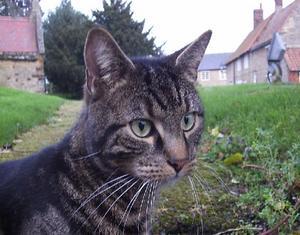The wild long-eared jerboa captured the hearts of people around the globe on December 10, 2007 when the Zoological Society of London (ZSL) released what is believed to be the first known video footage of the distinctive, rarely seen Euchoreutes naso–sole representative of an entire genus, which means that it is distantly related to all creatures on Earth. The big fuss over this desert mammal is, for some people, overshadowing current events, including political campaigns. It has been said in Hollywood-never work with children or animals. They steal the show.
How did such a tiny beast make such a big news splash? You know the answer if you’ve seen the video. All the news stations have it. But the best website on which to see the long-eared jerboa is on the edgeblog because there you also will see him try to ‘burrow under’ Dr. Jonathan Baillie’s foot. Dr. Baillie is the Programme manager for Evolutionarily Distinct and Globally Endangered (EDGE), run by the ZSL. He and Uuganbadrakh, also of EDGE, are responsible for spotlighting the tiny beast whose attributes are indicative of many other animals. The long-eared jerboa is said to have rabbit-like ears, a pig-like snout, a mouse-size body, and kangaroo-like hind-legs, with feet that Dr. Baillie has likened to snowshoes. His long tufted tail, however, is yet to be compared. The nocturnal beast lives in Little Gobi Desert in Mongolia and, perhaps, elsewhere. He eats insects, primarily. He hops; he digs and burrows. In fact, he digs two burrow types-short tubes into which he can quickly escape from predators and long tunnels with nesting chambers, where he sleeps–once he has plugged up the entry.
The long-eared jerboa is not only on EDGE’s endangered list but also on The International Union for the Conservation of Nature and Natural Resources (ICUN) Red List of Threatened Species. Why is it believed to be on the verge of extinction? For the same reason that so many other animals on such lists are. Man has disturbed Earth’s ecosystem. In this case, the sub-ecosystem of the 500,000-odd square miles of the Gobi Desert is losing its biodiversity-natural heritage.
Ironically, while the biodiversity of the Gobi Desert–composed of rocks, sand, and vegetation–is declining, the desert itself is expanding, rapidly. According to China’s Environmental Protection Agency, the desert expanded between 1994 and 1999 by 20,240 square miles-roughly half the size of Pennsylvania. In 2007, the Gobi Desert has to come to lie within 150 miles of Beijing’s doorstep.
This expansion is attributed to prolonged drought and the influence of Mongolia and China itself. The drought is leaving streams, rivers, and water holes to dry up. The sheep and goat herds of Mongolian and Chinese nomadic herders are overgrazing on vegetation. The ensuing barrenness is causing dust bowls that spread across masses of terrain. Thus, the expansion, rather than creating a greater habitat, is instead creating a greater wasteland. And an ever-encroaching ecological disaster for China.
To fend off this disaster, China is planting a Great Green Wall of trees. This afforestation project is expected to provide a 2,800-mile ‘shelterbelt of trees across the northwest rim of China skirting the Gobi Desert’. Begun in 2001, with an estimated cost of 23 billion dollars+, the Great Green Wall is slated for completion in 2074. But pollution is ruining the soil–some trees are not surviving–and funds are lacking.
As another ecological repair measure, China is encouraging herders to reduce their herds of sheep and goats by forty percent. But some experts believe that this would increase poverty and starvation. On the other hand, Jargal Jamsranjav, of Mongolian nomadic herder heritage, is developing and implementing ‘projects in the Gobi Desert to improve community livelihoods and (to train) nomadic herders in wildlife monitoring’.
Yet, even as some people work toward ecological healing, there are those who illegally mine gold in the Gobi Desert–they extract the gold using deadly potassium cyanide, which destroys vegetation-and there are those who illegally hunt, thus further endangering animals who are already losing their habitat. What were once remote areas are now accessible because of road construction and off-road vehicles.
And what of the wild long-eared jerboa-just one species of many who have made it onto conservation lists of endangered species? ZSL’s EDGE will conduct a study-to be carried out by a Mongolian Masters student–on the long-eared jerboa in order to determine an informed plan to ensure its long-term survival. A difficult task in the face of the desertification of the species’ home, the Gobi Desert.
But for now, the nouveau-famous long-eared jerboa happily hops in his habitat as usual. He is a hardy rodent. While the endangered Bactrian camel and predatory wolves need the fresh water that is diminishing (they die from drinking salt water), the long-eared jerboa does not drink water at all. Instead, he survives on water obtained from ‘food or produced by his own metabolism’. In fact, studies may show that he is like other jerboa types who are dormant during summer months or during periods of drought. Thus, if the vegetation that sustains insects–the primary food of the long-eared jerboa–can be restored, then the long-eared jerboa, with its adorable appeal to humans, will continue to exist. The late Steve Irwin, one of the greatest friends that nature’s beasts have ever had, would certainly wish it so.
1 http://www.edgeofexistence.org/edgeblog/?p=213
2 http://news.bbc.co.uk/2/hi/world/monitoring/media_reports/1199218.stm
3 For some viable ecological solutions, check out Alex Steffen here– http://www.worldchanging.com/archives/000252.html
4 http://theclimategroup.org/index.php/viewpoint/jargal_jamsranjav/
5 http://www.answers.com/topic/jerboa?cat=health
Other resources:
http://en.wikipedia.org/wiki/Gobi_Desert
http://www.edgeofexistence.org/conservation/long_eared_jerboa.asp
http://www.wildcamels.com/lopnur.htm
http://earth-policy.org/Updates/Update26.htm
http://en.wikipedia.org/wiki/Gold_mining
http://www.worldchanging.com/archives/000252.html






